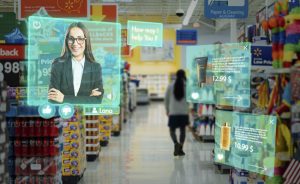Novelties in the field of consumer electronics, conceptual technologies are announced and issued with amazing speed and frequency. Virtual, augmented and mixed reality innovations are among them. Although these technologies have been introduced only recently, the initial attempts to develop such solutions were actually made almost 200 years ago. Then, it all started with a stereoscope, and today mixed reality even comes to mobile devices.
It should be noted, however, that the concept of mixed reality is still in its infancy. Therefore, developers are arguing about the unified approach to defining it. As a rule, it is referred to as a new reality where you can interact and manipulate both virtual and real objects using special sensor-based tools. The principles of mixed reality are very similar to those of augmented reality, with slight variances. So, many experts usually interrelate the two concepts.
Augmented and mixed reality solutions have been gaining momentum among users and businesses for a little over two years so far. The most famous of them are Magic Leap, Pokemon GO, LEGO® AR Playgrounds, and INKHUNTER. Mobile technologies were supposedly invented specifically for the implementation of such technology, and below we will tell why.
Definition of Mixed Reality

As the name suggests, MR makes it possible to integrate virtual elements into the real environment, and real objects into the virtual world. Sounds confusing, doesn’t it?
The essence of the technology is to bring virtual elements into your physical environment, visualize and arrange them with the real-world objects so that the user who sees them could also perceive them as real. This technology effectively combines the best features of AR and VR:
- ability to interact with the simulated environment;
- sense of immersion in the virtual environment;
- availability of powerful hardware like headsets;
- opportunity to explore and perceive the detailed virtual world.
Simply put, the user continues to interact with the real world, supplemented by virtual objects that are striking in their “naturalness”.
Applications and Means of Implementing MR
This is not a complete list of devices that allow developers to use mixed reality today, but they are certainly a must-have.
- projection rooms for creating an interactive environment;
- windshields, equipment with sensors and indicators;
- helmets and virtual reality glasses;
- tablet PCs, smartphones, mobile and computer devices.
Based on the diversity of technology, MR use cases are also quite diverse – by capabilities, by potential application areas, and by the requirements that are applied to the user.
Unlike VR that requires expensive equipment like helmets, controllers, and glasses, MR solutions can be developed in a less costly way. Through a mobile application, it can supplement the surrounding environment and add interactivity to it. Taking into account that by 2021, 6 billion smartphones will be used in the world, and users already spend 2 hours per day on average with applications, the implementation of MR in apps shows great promise.
The First Step in MR Realization on Mobile

The first major push for the introduction of MR to mobile devices was made by Google’s Project Tango. However, the Internet giant began to engage in such developments long ago, when all the necessary sensors and the computing unit took up quite a lot of space. Only recently they have managed to introduce the technology to regular smartphones thanks to their ARCore system. Using APIs, you can enable augmented reality experience via Android and iOS devices. Although not all phone models are now supported by ARCore, it is about to change as technology evolves and becomes more advanced.
This suggests that the integration of both MR and AR into mobile technologies still has a long way to go. And the first attempts have already been made. They have become quite successful, so let’s analyze them in more detail.
Perspectives of Mixed Reality in Combination with Mobile Technology
The MR concept is not new, but mobile technologies can make it more effective in combining real-world elements with virtual ones.
Mobile Games with Mixed Reality
Pokémon Go is a great example of a game in which MR is fairly well implemented. Due to the fact that Pokémon Go conquered the whole world several years ago, this game became the most famous use case of the mixed reality technology for mobile. The application still exists and is in demand.
Mobile Shopping Will Be More Efficient
IKEA has released a mobile application based on ARKit, which allows potential buyers to see whether the furniture fits in the house before buying. By combining digital space and real environment, MR can add new dimensions to shopping. And all this suggests that with MR we will spend even more time on mobile applications for retail.
Mixed Reality in Tourism
Smartphones have already become the main traveler’s companion today — they allow you to store boarding passes, book hotels, look for places of interest and restaurants. MR could make your mobile experience even more immersive. The opportunities are truly endless. For example, MR will be able to guide you around the airport, suggesting the fastest and shortest way in real time. Similar technology has already been developed in the UK. The idea of the project is as follows. More than 2,000 wireless beacons have been installed at the airport terminals. The system works by integrating with programs supporting 3D orientation and MR elements. Using special virtual elements and on-screen arrows, the system guides you to the desired location. This means that soon MR travelling apps will make navigation perfect and simple as never before.
To Sum It Up
2.7 billion people in the world use smartphones and all of them are potential users of mobile MR. At the same time, the number of those who have powerful desktop computers with all the technical specifications for helmets like Oculus Rift or HTC Vive is much smaller. These special PC tools are also several times more expensive than their mobile counterparts, and can exceed $1,000 (including a helmet, a computer, additional accessories, and so on).
That is why the mobile industry is the fastest growing segment of the MR market, and we will be able to personally observe that mobile and mixed reality technologies will become inseparable in the coming years.

